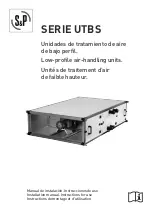
25
Commissioning and Maintenance
Basic cleaning and maintenance tasks
ELECTRICAL HAZARD AND DANGER FROM ROTATING UNIT PARTS!
OBSERVE PERSONAL PROTECTION MEASURES.
In doing so, be sure to observe the safety information on page 24.
• Remove excess dirt by wiping it off using a dry cloth or, if necessary, an industrial
vacuum cleaner.
• Remove dirt that accumulates due to the constructional installation of additional
accessory parts.
• Other types of soiling: remove with a dry cloth, and wash off using a little water with
added alkaline cleaning agent if necessary.
• Do not use abrasive cloths or tools that may scratch or scrape the protective surface
during cleaning as this will cause irreparable damage.
• Treat galvanised parts with preservative spray.
• Apply lubricant spray to all moving parts, such as door levers and hinges – dampers
excluded!
• Clean the seals on the inspection doors and check for leaks.
It is recommended that seals are treated with a moisture-repellent preservative.
• Check electrical connections.
• Check earthing.
Basic information regarding the cleaning of fins
ELECTRICAL HAZARD AND DANGER FROM ROTATING UNIT PARTS!
OBSERVE PERSONAL PROTECTION MEASURES.
In doing so, be sure to observe the safety information on page 24.
DANGER FROM SHARP EDGES!
There is a danger that the thin fins will inflict cuts during cleaning.
The fin package must be cleaned to ensure that the heat exchanger continues to operate
at full capacity. This can be carried out using a brush (not wire brush) or an industrial
vacuum cleaner. Do not use hard or sharp cleaning tools!
Copper or aluminium fins may be blown out against the direction of the airflow using
compressed air, or sprayed with water at low pressure for cleaning.
Steel galvanised heat exchangers or heat exchangers with reinforced fins may also be
cleaned using steam jet cleaning appliances.
Maintenance interval checklist
The maintenance intervals as defined in European guidelines and standards (e.g. VDI
6022) must be observed.
ELECTRICAL HAZARD, DANGER FROM ROTATING UNIT PARTS AND SHARP
EDGES! OBSERVE PERSONAL PROTECTION MEASURES.
Be sure to observe the safety information on page 24 and page 25
when carrying out the
maintenance work described below.











































